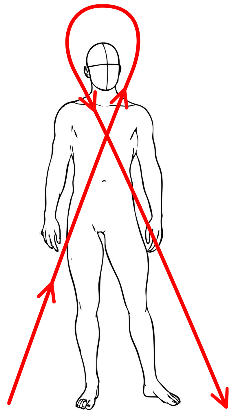Wechselhauw
(→Application Example) |
|||
| Line 3: | Line 3: | ||
Meyer describes this as any strike which changes from above to below, left to right. Mair provides a more specific execution which we will use. | Meyer describes this as any strike which changes from above to below, left to right. Mair provides a more specific execution which we will use. | ||
| − | ==Execution== | + | ==Longsword== |
| + | |||
| + | ===Execution=== | ||
Mair describes a more specific action as follows: | Mair describes a more specific action as follows: | ||
| Line 17: | Line 19: | ||
[[File:wechselhauwLine.png | center]] | [[File:wechselhauwLine.png | center]] | ||
| − | ==Application== | + | ===Application=== |
In keeping in line with Meyer's description of the strike (rather than Mair's used here) we could also use the strike with a slash up and slash down on the same line so that we slash up to the high right, then down from the high right back to the wechsel in which we started. | In keeping in line with Meyer's description of the strike (rather than Mair's used here) we could also use the strike with a slash up and slash down on the same line so that we slash up to the high right, then down from the high right back to the wechsel in which we started. | ||
| − | ==Application Example== | + | ===Application Example=== |
In which the 'student' demonstrates their knowledge to the 'teacher'. | In which the 'student' demonstrates their knowledge to the 'teacher'. | ||
| Line 39: | Line 41: | ||
| [[Passing Step]] forward, [[zornhauw]] to opponent's right upper opening. | | [[Passing Step]] forward, [[zornhauw]] to opponent's right upper opening. | ||
|} | |} | ||
| + | |||
| + | ==Dussack== | ||
| + | |||
| + | All cuts which go from one opening to another with the dussack are considered to be change cuts. For example an unterhauw followed by a zornhauw is a change strike. | ||
Revision as of 05:11, 18 July 2016
Contents |
Change Strike
Meyer describes this as any strike which changes from above to below, left to right. Mair provides a more specific execution which we will use.
Longsword
Execution
Mair describes a more specific action as follows:
"When you come to the closing with the opponent and strike in the Wechsel (Changer), set your left foot forward and strike from below at his face such that the short edge stands high. Then step outward with your right foot and strike with the long edge to the right side of his head."
Essentially from Wechsel on the right (left foot forward) we slash up with the false edge along the lower-right to upper-left diagonal, then keeping the momentum of the sword going, and with a passing step forward and to the right, we cut back down along the upper-right to lower-left diagonal, which would end in wechsel on the left if we continued the cut through.
The pattern of the sword tip’s motion is show in the image.
Note that the slash can go all the way up to vom tag (creating a larger movement), or simply up to eisenport (a tighter, but less powerful movement).
Application
In keeping in line with Meyer's description of the strike (rather than Mair's used here) we could also use the strike with a slash up and slash down on the same line so that we slash up to the high right, then down from the high right back to the wechsel in which we started.
Application Example
In which the 'student' demonstrates their knowledge to the 'teacher'.
| Teacher | Student |
|---|---|
| Zornhut, left leg forward | Wechsel, right leg forward |
| Passing Step zornhauw | False edge slash up along the left to right diagonal, ending in Vom tag |
| Passing Step forward, zornhauw to opponent's right upper opening. |
Dussack
All cuts which go from one opening to another with the dussack are considered to be change cuts. For example an unterhauw followed by a zornhauw is a change strike.
